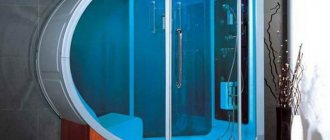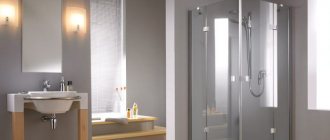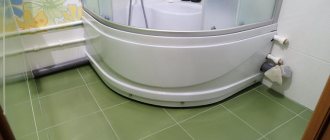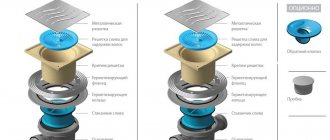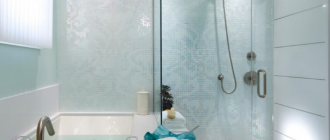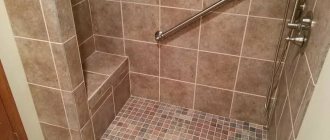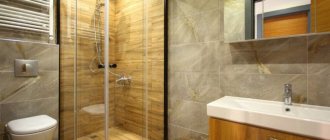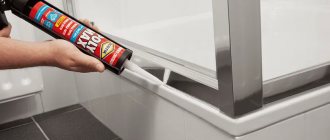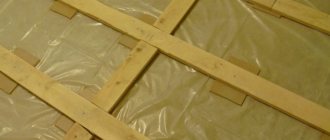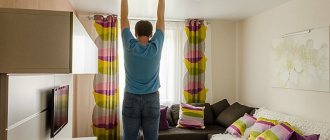Shower cabins are becoming increasingly popular among bathroom products. Convenience and functionality come first for the consumer, so large, uncomfortable cast-iron bathtubs of standard sizes are becoming a thing of the past; also, in many new buildings, bathroom space is very limited. This is where a shower stall will come in very handy, whether you have a large or small bathroom.
Purchasing and installing a shower cabin will allow you to increase the usable space in your bathroom, especially if your bathroom is not large. You can easily place a washing machine, bath furniture and much more there.
Choosing and purchasing a shower cabin is only half the battle; you still need to assemble and install it.
I would like to say that a shower cabin is a product in which 70 percent service life and reliability
This is a kind of construction set that you must assemble correctly, with high quality, and then it will serve you for many years.
Please note that the shower cabin is assembled in a finished, clean room; all finishing work must already be completed.
Using these instructions, you can assemble most shower cabins with a glass back wall, either 90 by 90 centimeters, 80 by 80 centimeters, or 100 by 100 centimeters.
We also note that assembling a shower cabin with a high tray is no different from assembling a shower cabin with a low tray . The only difference will be in preparing the space for the shower stall.
Assembling the shower cabin is best done with two people; the approximate assembly time is about 3 hours.
To assemble the shower cabin you will need the following tools
The shower cabin is not included in the package!
- Sealant (with application gun)
- Screwdriver
- Drill Ø1-3mm
- Phillips screwdriver
- Pencil
- Pliers or wrenches
- Level
According to the manufacturer, some shower cabins are assembled without sealant. But even for these types of showers, you will still need a sealant . They need to process the shower drain hole, install water traps and magnetic seals, and other small options if available, such as processing the hole for the radio and nozzles.
In all other shower stalls, sealant is required.
With its help, all fixed elements are processed. The joints of the rear wall between the central panel and the pan, the joints of the front frame and the pan, fastening the drain and nozzles, installing seals and water shut-offs.
Glass shower cabins are supplied unassembled, in cardboard boxes. The number of boxes per shower cabin is from 3 to 5 (depending on the manufacturer)
Universal scheme for preparing communications
This assembly scheme is suitable for almost all shower cabins, for example, using this scheme you can assemble a shower cabin measuring 80 by 80 centimeters, 90 by 90 centimeters, 100 by 100 centimeters.
General diagram of the shower cabin assembly
Stage one
First of all, before assembling the shower cabin, unpack all the boxes and take out all the components and components.
Lay them out and check that all components are in place.
A standard shower enclosure with a glass back wall consists of the following assembly units
Pallet (some manufacturers supply the pallet assembled; if your pallet is not assembled, then you will have the following spare parts in the box with the pallet)
- Pallet
- Roof
- Front decorative screen
- Horizontal profiles - 2 pieces (upper and lower)
- Frame
- Components for assembling the frame and attaching the decorative panel (studs, bolts, legs)
Very often, all of the above components are contained in one box. This is the biggest box. Also, inside there may be a box with all the components, where you can find everything to assemble the shower cabin.
If you can't find the threaded rods for the legs and frame, shake the frame itself; some manufacturers put the studs inside the frame.
Back wall
- Two glasses of the same size
They can be immediately framed with aluminum profiles, or just two glasses if the back wall is assembled at the corners.
These two walls differ from each other in the presence of holes already drilled in them for components. Such as a shelf, mirror, foot massage, hand shower and others.
To understand which glass is right or left, look at the product image on the instructions or on the Internet. There you will see the configuration of your shower cabin, and on which side the options are located
Front windows
- Fixed glass - 2 pcs.
- Doors - 2 pieces (curved glass with holes for rollers and handles)
- Horizontal profiles - 2 pcs.
- U-shaped seals (2 or more pieces)
- Magnetic seals on the door - 2 pcs (may already be attached to the doors)
- L-shaped cutters (2 or 4 pcs)
Central pillar
It may come with options already screwed on, such as a faucet or lighting. Also, very often, inside, on the back side, various seals and other small spare parts are placed directly into the panel .
- Video instructions for assembling shower cabins
Accessories
Mandatory components that all shower cabins have
- Rollers for doors
- Pens
- Mixer
- Hand shower
- Hand shower holder
- Siphon drain
- Side window holder corners
- Fastening elements (Screws, bolts, washers, clamps)
Components that depend on the configuration of the shower cabin
- Injectors
- Rain shower
- Options control panel
- Radio speaker
- Backlight bulbs
- power unit
- Foot massager
- Steam generator
- Seat
- And so on
That is, at this stage, knowing the complete set of your shower cabin, you can visually inspect before assembly and understand what is screwed where, or suddenly something is missing.
How to check the quality of parts?
Before installing the cabin in the bathroom, you need to make sure the quality of the components. To do this, the product is pre-assembled in a spacious room and without the use of sealant . Cabins with a ceramic tray are installed using a jigsaw.
Pallet: ceramic, steel or cast iron, acrylic (the latter is at the peak of popularity).
- Thin sanitary ware has a high chance of cracking or breaking - look at the thickness .
- Steel trays are supplied on adjustable legs, with a bottom treated with polyurethane foam and rubber gaskets underneath (so that the water jets do not create a rumble when they meet the surface). If there is no such protection, using the shower will be inconvenient.
- Acrylic needs additional support in the form of a support system , a metal frame or fiberglass bottom reinforcement. Check for the presence of parts that provide rigidity to the structure.
Scratches and chips on the frame, and even more so broken parts, are unacceptable . Test small parts for geometric consistency.
The glass is in packaging, but in the box it is not visible whether it remained intact after transportation. , tempered glass with a thickness of at least 6 mm is used for booths , which is enough to withstand many mechanical impacts. But to check, shake the box - if there is no characteristic noise of broken glass, then everything is fine. It is better to order sliding glass doors from Almetagroup.
Stage two.
Before assembling, place the remaining cardboard boxes on the floor . This way, you will assemble the pallet and, most importantly, the glass without damage.
Never place glass on a bare floor, especially tile or concrete.
In general, handle shower glass very carefully during assembly. Although tempered safety glass used in shower enclosures is very strong, it does have weak points, especially at the corners. Never place glass on a corner. Do not drill holes in the glass, it will simply crumble into small fragments.
All the necessary holes are already there and were made at the factory. If, in your opinion, a hole is missing, it means this is a manufacturing defect, or the manufacturer has replaced the equipment.
Shower in the room's recess
A shower of this type does not need a tray , because...
water flows into the drain due to the slope of the floor. An alternative option is a drainage system. Convenient in cases where even the smallest pallet is too high for some family members (for example, for the disabled and the elderly). A special feature of the installation is the installation of a water collection system (stairway or channel). The pipe and siphon are placed inside the screed. According to the rules, the sewerage system is located with a slope towards the riser.
Waterproofing of walls and floors near the shower stall in this case should be of particularly high quality and use antifungal agents . A special cuff is laid on the floor, which surrounds the drainage ladder. The cuff covers the main waterproofing layer to eliminate the possibility of leaks.
The sound of water transmitted to the rooms on the lower floor can be muffled by soundproofing . Some drainage drains are initially designed to absorb unnecessary sounds.
Stage three
Assembling the pallet
If your shower cabin comes with a tray already assembled, then you can skip this step, except for the level adjustment item.
1. Turn the pallet upside down and place it on the floor, previously covered with cardboard from the packaging, or lay down a cloth.
2. We screw the legs and studs onto the frame and try the frame on the pallet.
We try on the frame, taking into account that all its holes for fastening, both at the bottom of the pallet and at the corners of the pallet, fall on the embedded parts (these are those parts on the back side of the pallet that stick out and are intended specifically for attaching the frame there)
Attention! Some manufacturers may have a frame without holes, then after trying on the frame on an inverted pallet, you must make such holes yourself. Also, for some manufacturers the holes may not match or be in a completely different place, in which case you need to make new holes based on the correct installation of the frame.
After you have tried on the frame, secure it to the pallet with self-tapping screws.
Attention! Be sure to check the length of the screws so that you do not accidentally screw in longer screws. Otherwise, they will come out inside the pallet and damage the pallet!
3. Screw on the drain siphon
Be sure to coat the places where the drain is attached to the pan with silicone sealant.
4.Install the front decorative panel
Most often, such a panel is attached using self-tapping screws and closed with decorative plugs.
5.Remove the protective film from the tray and front decorative panel
6.Move the tray into place and use the feet and level to adjust it to the correct position. Tighten all nuts with a wrench and check the level again.
Install a siphon
Shot: @Alexander Kvasha / YouTube
Find the parts of the drainage system and assemble it according to the included instructions. Turn the pan on its side and install the siphon. To do this, remove part of the protective film around the drain hole, insert the siphon socket into it, after installing the gaskets. Screw the union nut onto the reverse side and tighten it by hand.
If you are not sure about the quality of the seals, coat all joints with sealant, but keep in mind that disassembling the joint will be problematic later. Typically no additional sealing is required.
Try the drain onto the sewer socket, but do not connect it yet. It’s more convenient to do this at the very end, after assembling the booth (when you slide it into place).
Stage five
Rear wall assembly
This stage is best done together with an assistant.
We carefully look at where our right and left walls are.
Option for assembling rear walls framed with profiles
We place the glass and the central panel on a pallet, and using self-tapping screws or bolts (depending on the manufacturer) we fasten the side walls with the central panel together.
Seal the joint between the central panel and the side walls with silicone sealant.
Option for assembling rear walls at corners
1. Place the right and left glass on the pallet and secure it with self-tapping screws, installing the side corners at the top and bottom
2.Install the center post between the rear walls
3.According to the guide holes on the sides of the rear walls, connect the central post to the walls with self-tapping screws, securing the side corners at the top and bottom.
Stage six
Front frame assembly
- Connect transverse (arched) and longitudinal (straight) aluminum profiles using self-tapping screws
- Install the front side fixed windows into the groove of the longitudinal profile, having first placed a silicone U-shaped rubber seal on the glass.
If the glass is difficult to insert, do not try to knock on it, do not hammer it in. Try to spread a little silicone sealant on the U-shaped seal and carefully, with pressure, without bending or deforming the glass, try to insert it into the groove.
3.Press the free edge of the glass with the corners of the front walls using self-tapping screws.
Stage seven
1.Place the front frame on the pallet
2. Connect the front frame and the back wall together using self-tapping screws or bolts (depending on the manufacturer). First check that they stand level and do not protrude anywhere.
3.Secure the back wall to the pallet using self-tapping screws or bolts. (depending on the manufacturer).
Attention! If you do not have holes for bolts, you will need to make them yourself using a drill, which may not be included in the kit.
Basic nuances when installing a shower stall
The main thing when installing a shower stall is to choose the right place for installation. It should be next to the hood and, if the model has many additional functions, connected to the electrical network with mandatory grounding. When assembling the pallet, you need to use a building level, since the pallet must be installed strictly horizontally. When installing a pipeline, be sure to use sealants, otherwise water leakage will force you to redo the entire job. When connecting the cabin to the water supply, you must install at least one filter. All pipes are run along the baseboards or hidden in a box or wall.
Let's look at a detailed example of installing a shower stall using Massimo as an example. This is a corner booth made in China with a high tray. Size - 100x100 cm. Bought for 30 thousand rubles. For other models and manufacturers, assembly may vary.
Stage eight
Door assembly
1.Attach the upper and lower rollers to the doors, with the wheels facing outward
2.Attach the door handles to the holes on the sides of the doors.
3.Using sealant, install the shutters and magnetic seals on the door
4.Install the door stops on the upper and lower cross sections
5.Hang the doors on the upper rollers, placing the wheels in the groove of the cross profile.
6.Snap the lower rollers into the lower roller slot by lowering the wheel.
7.Adjust the rollers so that the shower doors close tightly and move effortlessly along the guides.
Frame option No. 2:
- We assemble it as in the photo. The only rule is to first fold it without twisting it
(try it on) so that the mounting plates with holes are on one side. Tighten without applying any force. The profile bends and loses rigidity. Also, a nut that is welded rotten may fall off.
- All operations are basically similar to the first version of the pallet. Only “hemorrhages” in the additional assembly of the shower cabin frame with your own hands. In order to quickly and evenly screw in all the studs to an equal depth in one plane, I used to use a tape measure, measuring the distance from the floor to the end of the stud, and then the legs.
- It is better not to measure from the body of the tray; it is rare to come across even shower trays, and especially even ones at the bottom. Now I have improved the method using a laser level. Everything is done much faster.
Important:
- Be sure to adjust the fit of the bottom of the apron to the brackets (the main thing is perpendicularity and normal curvature of the circle). Then it will be very difficult to do...
Stage nine
Roof assembly
Remove the protective film from the roof and attach a speaker, hood light, and rain shower (if included) to the roof.
Secure the roof to the shower stall using self-tapping screws or bolts (depending on the manufacturer)
The roof is usually attached only to the rear wall
Video description
How to install a shower tray in the video:
Connecting communications
Without a sewer connection, not a single shower cabin will function. The procedure takes place in five stages:
- Removing the protective film from the drain hole.
- Replacing the rubber gasket with silicone sealant. Carried out at the request of the customer.
- Siphon installation.
Siphon structure Source wodolei.ru
- Secure the lower fastening with sealant.
- Connection to sewerage. The connection is also treated with sealant.
It is necessary to take care of waterproofing. Water should not come into contact with the electrical network even during flooding. In addition, it is necessary to take into account the installation of accessories, washing machines, sinks, etc.
Doors, walls, roof
Due to differences, there are some differences in the installation process of doors, walls and roofs. For this reason, installation is carried out exclusively according to the instructions included with the model. Bolts are used to secure the walls.
Wall installation is carried out in accordance with the following algorithm:
- The protective film is removed only from the top of the pallet. The reason is that the bottom may be damaged by the following operations.
- The pallet moves away from the wall.
- The pallet is connected to the walls using corners. Self-tapping screws are tightened without applying any serious effort.
- Some of the corners will have special holes. These elements are marked with a marker.
- The partition is removed to apply silicone.
Glass cabin without partitions Source omerkoch.co
Stage eleven
Connection to communications
1. Connect the hoses coming from the mixer to the hand shower, rain shower and to the nozzles (if any)
2.If you have an electrician, connect the wires going to the lighting, hood, and radio.

